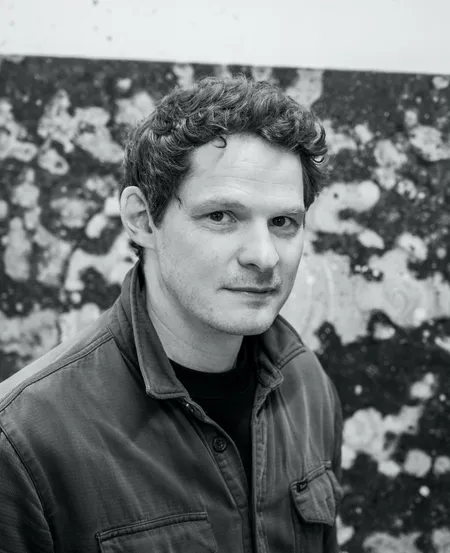Ed Saye

Degree: MFA
University: Slade
Graduation Year: 2009
New Blood Art Commentary
Ed Saye’s paintings hold the strange beauty of a world still running its rituals after the meaning has shifted. Figures walk, gather, hold small suns in their hands, unaware of how altered the air has become. The colour hums at a frequency between reverence and re-coding - radiant, hyperreal, irresistible - the saturation dial turned just past natural, where colour starts to behave as energy instead of pigment. His work has evolved with rare coherence, each canvas reorganising itself from within, as though the paint were recalibrating to each new atmosphere - the pigment edging toward another register entirely.
See inside the studio of Ed Saye
See investable artists
See Investment tip II
See investment tip I
Artist Statement
I make paintings of hippie-like dudes doing everyday things. These dramatic, fantasy scenarios, with highly saturated colours and dramatic light, are inspired as much by high art as videogame culture.
The figures - mid-swing, mid-drink, idle - inhabit dreamy, fragmented worlds. They keep going, even when the meaning of what they’re doing has thinned or disappeared. I’m interested in that persistence.
My process involves working from found photographs, digital image-making, and AI. I disrupt the image by dripping or printing paint using offcuts of canvas. These haphazard actions flatten the space, break the illusion of narrative, and push the work toward something more atmospheric.
As one writer described it, “Saye’s latest body of work explores themes of masculinity, environmental collapse, and escapism through a series of paintings featuring awkward, hippie-like characters that play golf, flip burgers, drink cocktails, lounge, flop and idle in dreamy landscapes.” (unattributed artist bio)
Paul Carey-Kent described my work as “high contrast content versus low contrast means,” noting how “human constructions are set against nature, modernity against decay, and mainstream culture against alternative society.” He also wrote that I use “elaborately indirect techniques to make post-idealist images,” and that “today’s promising future is tomorrow’s disappointing history.” (No Promised Land, 2017)
That sense of dissonance - of things continuing past their moment - is what I’m painting. Not a critique. Just a surface that’s still active, even after the meaning has moved on.
Solo Exhibitions
(2025) Once Emerged from the Grey of Night, Chapel Arts Studios, Andover
(2016) No Promised Land, The Foundry Gallery, London
(2013) Isolation Room, Isolation Room, Copenhagen
Group Exhibitions
(2025) Traces, CAS, Andover
(2024) Belonging, CAS, Andover, UK
(2023) Open Open, Chapel Arts Studios, Andover, Hampshire
(2023) Works on Paper 5, Blue Shop Gallery, London
(2023) A Generous Space 3, Huddersfield Art Gallery, Huddersfield, UK
(2023) to the birds, curated by Dan Howard-Birt, Exeter Phoenix, Exeter, UK
(2021) your FOOT in my FACE, Kingsgate Project Space, London
(2019) Reconstructing the Reality, Peyer Fine Art, Zurich
(2018) The SOLO Award 2018, Chiara Williams Contemporary Art, The Cello Factory, London
(2018) Beautiful Monsters, The Portico Library, Manchester
(2018) Beep Painting Prize 2018, Elysium Gallery, Swansea
(2018) Reconstructing Reality, 20:20 Iconic Art Vision at D10 Art Space, Geneva
(2018) The Landscape of Time, Contemporary British Painting, St Marylebone Crypt, London
(2017) Virtuality Mortality, Ugly Duck, London
(2017) Ruth Borchard Portrait Prize, Piano Nobile, London
(2016) Runaway Fingers, Pushkin House, London
(2016) Daylight Saving, Geddes Gallery, London
(2013) This Glitch, curated by Lee marshall, Blythe Gallery, London
(2013) Creekside Open selected by Paul Noble, A.P.T. Gallery, London
(2012) The Other Art Fair, Ambika P3, London
(2010) Grammar See, Rod Barton Gallery, London
(2010) Lead Slugs and Blank Spaces, Museum 52, London
Competitions, Prizes & Awards
(2013) Creekside Open - Finalist
(2017) Ruth Borchard Portrait Prize - Finalist
(2018) The SOLO Award - Finalist
(2022) Contemporary British Painting Prize - Longlisted
(2022) Studio In View Award - Artist Support Pledge - Prizewinner